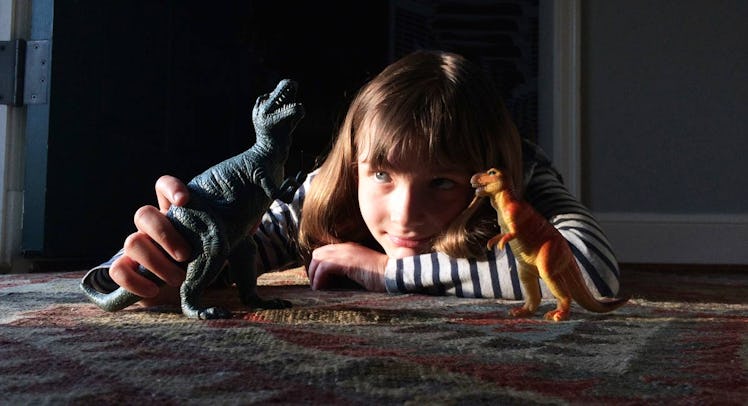What Parents Need To Know About the Psychology Of Imaginary Friends
They might be bizarre and they can be spooky, but imagined amigos are ultimately a sign of healthy development.

When an imaginary friend unexpectedly shows up in the house, he, she, or it can feel like a real presence. That’s because kids can develop a rich and meaningful relationship with pals that don’t exist but nonetheless seem to have agency, personality, and sometimes even demands. It is not uncommon–though also not terribly common–for invisible interlopers to become real enough that parents develop a certain affection for one of their child’s neurological patterns. But despite co-habitating with families around the globe, imaginary friends remain mysterious. How do they come to be and why do they eventually disappear? And what if they never show up in the first place?
“Having an imaginary friend is definitely common and it’s definitely normal,” explains Celeste Kidd, cognitive researcher and co-director of the University of Rochester Kid Lab. “Most imaginary friends should not raise an eyebrow for parents. But it’s also normal for kids not to have imaginary friends. That’s not a problem either.”
Given that there’s little concern for whether or not an imaginary friend emerges from a child’s brain, a parent might be forgiven for discounting their child’s invisible purple pony or sentient rainbow. But it turns out these strange, invisible inhabitants of the family room—known to researchers as “social beings” given their wild diversity—actually mark an important milestone in the cognitive development of a child.
An imaginary friend can’t exist until a child is able to develop the concept of how another social being, separate from themselves, behaves and reacts in certain situations. Interacting with this unique social being, then, is a simulation. It’s the kid version of stepping into a virtual reality. No equipment necessary.
“Imaginary friends tend to develop in kids at a time when kids are increasingly becoming socially aware,” Kidd explains. “In order to simulate another social being you need to be able to understand a lot about what people are like.”
That understanding includes the way social agents behave and the way they might react in certain situations. Having an imaginary friend is essentially the same as pretending to run a restaurant or play house. Those types of play are evidence that a kid is learning how social processes and physical tools work. And they’re learning about these social processes and tools through simulation. Essentially they are able to explore cause and effect in a super low stakes way. Better to imagine an argument with an imaginary friend than have a dust up with the real one. Better to explore the social ramifications of partnership by playing house than committing to a long term relationship at 5 years old.
The Three-Pronged Approach to Imaginary Friends
- Don’t stress. Not only do imaginary friends indicate a cognitive milestone, they are basically a form of imaginative, healthy play.
- Normalize and embrace a kids imaginary friend, but contact a pediatrician if there are sudden changes in day-to-day behavior.
- Avoid insisting a child should ditch an imaginary friend at a certain age, which is mostly cultural, not scientific.
“You can think of imaginary friends as serving some of those same roles as other types of imaginary play,” explains Kidd.
The definition of what an imaginary friend is remains pretty broad. For some kids it might be a creature spun whole cloth from the stuff of bizarre dreams. For other kids, it’s a stuffed animal imbued with social agency. They can be characters gleaned from pop-culture (after all, the heavy lifting has been done). Some researchers even suggest that kids inhabiting a distinct character are engaged in “imaginary friend” play. The important part is that whatever social agent is generated, it has its own likes, dislikes and personality traits.
Sometimes those personality traits can be odd or unnerving. And while that’s not necessarily cause for concern, Kidd notes that anytime a parent feels there’s something off with the behavior of their child, it never hurts to ring their pediatrician. “If they’re engaging in behavior that a parent finds disturbing, or their preschooler or elementary school child is describing things they shouldn’t know about and attributing them to an imaginary friend, it might be time to check in,” she says.
But, for the most part, imaginary friends are largely benign. Sure, a child might blame their spilled milk on their invisible pal, but that’s not a sign of sociopathy. It’s a sign that they’re demonstrating some sophisticated understanding about the social world. In the case of blaming mischief on Sparkles the Unicorn, they’re demonstrating knowledge about the behavior of social beings outside themselves, how different social beings may have different goals, and how parents might react if there were another social being involved in certain circumstances.
Largely, a parent never needs to worry about an imaginary friend. Even if they happen to linger past what would be considered an appropriate age. That’s because the age at which people say imaginary friends should disappear is mostly cultural, not scientific. Kidd points to the South American Pirahã tribe who engage in a type of “imaginary friend” play well into adulthood. Adult members of the tribe even transform into spirits. Tribe members will wander into the jungle, return to the village as a spirit, often naked, and engage in mischief and storytelling. Then, they will go back into the woods, dress and return, essentially asking what they missed while they were gone. Everyone plays along.
But should a parent ever worry about encouraging imaginary friends by playing along? Kidd answers with a question of her own: “When your children ask you to play restaurant and they bring you playdough and you pretend to eat it, are you worried they’re going to believe it’s food?” No. Unlikely.
“This is another kind of play,” Kidd says. “Kids know there’s a difference between play and real.”